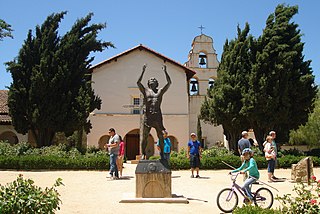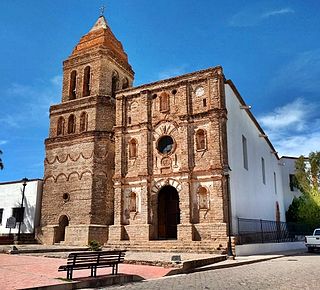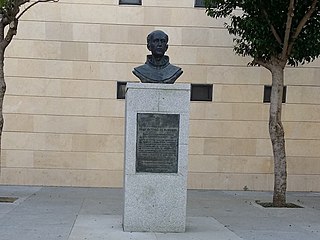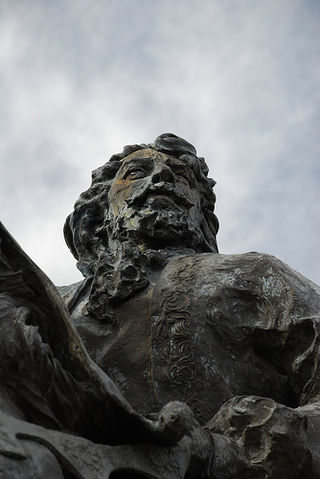
San Juan Bautista is a city in San Benito County, in the U.S. state of California. The population was 2,089 as of the 2020 census. San Juan Bautista was founded in 1797 by the Spanish under Fermín de Lasuén, with the establishment of Mission San Juan Bautista. Following the Mexican secularization of 1833, the town was briefly known as San Juan de Castro and eventually incorporated in 1896. Today, San Juan is a popular tourist destination, as the home of the San Juan Bautista State Historic Park and other important historic sites, as well as cultural institutions like El Teatro Campesino.
San Juan Bautista is the Spanish-language name of Saint John the Baptist. It may refer to:

The West South Central states, colloquially known as the South Central states, is a region of the United States defined by the U.S. Census Bureau as covering four states: Arkansas, Louisiana, Oklahoma, and Texas. The West South Central or South Central region is located within the Southern United States and Gulf Coast regions, bordering the Mountain states and Midwestern U.S. regions to its north and west. The Gulf of Mexico is to the south of the region. Houston is the South Central's largest city, and the Dallas–Fort Worth–Arlington metropolitan statistical area is the region's largest metropolis.

San Ignacio is a town in Mulegé Municipality, Baja California Sur. The town had a 2020 census population of 521.

The Spanish missions in Mexico are a series of religious outposts established by Spanish Catholic Franciscans, Jesuits, Augustinians, and Dominicans to spread the Christian doctrine among the local natives. Since 1493, the Kingdom of Spain had maintained a number of missions throughout Nueva España in order to preach the gospel to these lands. In 1533, at the request of Hernán Cortés, Carlos V sent the first Franciscan friars with orders to establish a series of installations throughout the country.

Misión San Juan Bautista Malibat, also known as the Misión San Juan Bautista de Ligüí, was founded by the Jesuit missionary Pedro de Ugarte in November 1705, about 30 kilometres (19 mi) south of Loreto near the Gulf of California coast of what is today the Mexican state of Baja California Sur. The mission is located at 25°44′22″N111°15′51″W.

Felipe de Neve y Padilla was a Spanish soldier who served as the 4th Governor of the Californias, from 1775 to 1782. Neve is one of the founders of Los Angeles and was instrumental in the foundation of San Jose and Santa Barbara.

Arizpe is a small town and the municipal seat of the Arizpe Municipality in the north of the Mexican state of Sonora. It is located at 30°20'"N 110°09'"W. The area of the municipality is 2,806.78 sq.km. The population in 2005 was 2,959 of which 1,743 lived in the municipal seat as of the 2000 census.
Martín de Alarcón was the Governor of Coahuila and Spanish Texas from 1705 until 1708, and again from 1716 until 1719. He founded San Antonio, the first Spanish civilian settlement in Texas.

Antonio de San Buenaventura y Olivares or simply Fray Antonio de Olivares was a Spanish Franciscan who officiated at the first Catholic Mass celebrated in Texas, and he was known for contributing to the founding of San Antonio and to the prior exploration of the area. He founded, among other missions, the Alamo Mission in San Antonio, the Presidio San Antonio de Bexar, and the Acequia Madre de Valero.

Francisco Cuervo y Valdés was a Spanish politician who governed Nuevo León (1687-1688), Nueva Extremadura (1698–1703), New Philippines (1698–1702), and Santa Fe de Nuevo México (1704–1707).

Presidio de Béxar was a Spanish fort built near the San Antonio River, located in what is now San Antonio, Texas, in the United States. It was designed for protection of the mission San Antonio de Valero and the Villa de Béjar. The Presidio de Béxar was founded on May 5, 1718 by Spanish colonial official Martín de Alarcón and his party of thirty-five soldiers. The Villa de Béjar is known for being the first Spanish settlement of San Antonio and consisted of the families of the Presidio Soldiers and those of the prior expeditions. It also served to secure Spain's claim to the region against possible encroachment from other European powers.
The Ervipiame were an Indigenous people of what is now northeastern Coahuila and southern Texas. They were a Coahuitecan people, who likely merged into the Tonkawa.
The Xarames were an Indigenous people of the Americas of the San Antonio, Texas region. They were the dominant Native American group during the early history of Mission San Antonio de Valero. They were a Coahuiltecan people.
Mission San Juan Bautista may refer to any of the following missions, all of which are named for John the Baptist:
Diego Ortiz Parrilla was an 18th-century Spanish military officer, governor, explorer, and cartographer.
José Domingo Ramón was a Spanish military man and explorer who founded several missions and a presidio in East Texas to prevent French expansion in the area.
Mariano Valera was a Novohispanic military man who served as a captain in Guajoquilla, Coahuila, lieutenant governor of Manuel Maria de Salcedo in Texas, chief of the Texas government department, and commander of the military garrisons that defended the province's presidios. He also served, briefly, as interim governor of Texas in 1815, replacing Cristóbal Domínguez, as did his predecessor Benito Armiñán, although he only governed for a week or one year.
San Juan de Taperas is a village in San José de Chiquitos Municipality in Chiquitos Province, Santa Cruz Department, Bolivia. The ruins of the mission of San Juan Bautista, one of the Jesuit Missions of the Chiquitos, lie near the village. Since only the ruins of a stone tower survive near the present village of San Juan de Taperas, San Juan Bautista is not one of the six Jesuit Missions of Chiquitos recognized as UNESCO World Heritage Sites.











